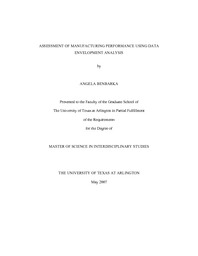
ATTENTION: The works hosted here are being migrated to a new repository that will consolidate resources, improve discoverability, and better show UTA's research impact on the global community. We will update authors as the migration progresses. Please see MavMatrix for more information.
Show simple item record
| dc.contributor.author | Benbarka, Angela Janette | en_US |
| dc.date.accessioned | 2007-09-17T17:07:25Z | |
| dc.date.available | 2007-09-17T17:07:25Z | |
| dc.date.issued | 2007-09-17T17:07:25Z | |
| dc.date.submitted | May 2007 | en_US |
| dc.identifier.other | DISS-1700 | en_US |
| dc.identifier.uri | http://hdl.handle.net/10106/551 | |
| dc.description.abstract | In today's global and highly competitive economy, organizations are constantly monitoring their performance and the performance of their competitors. With technological advancements and increased expectations from consumers, time becomes a critical factor in an organizations' ability to sustain their advantage over competitors. By understanding the multiple components which compose their performance and quickly identifying and addressing inefficiencies within the systems, an organization can maintain and possibly increase their share of the marketplace.
This research will assess the feasibility of data envelopement analysis (DEA) as a tool for organizations to measure their performance over time. DEA has been widely used and accepted as methodology for performance evaluations and benchmarking. The basic concept of directing methodology at frontiers rather than central tendencies such as statistical regression, gives DEA an advantage over previous, traditional methods. DEA is capable of identifying relationships among entities that traditional methods are not able to identify. It quantifies relations of entities in a direct manner without requiring several assumptions or variations on data sets.
DEA will be applied to a manufacturing facility for assessment of the facility's monthly performance and distinction of good performing months from poor performing months. The manufacturing facility is one of many manufacturing facilities of a large publicly-owned corporation. The facility has a large product mix with over 100 different formulations, resulting in multiple inputs to multiple outputs. Faced with the large product mix, executives from the manufacturing facility are constantly challenged to meet productivity levels and maintain an edge on their competitors all the while fulfilling customer expectations, meeting industry regulations, and staying abreast technological advancements.
This research will provide a mechanism for manufacturing executives to easily and rapidly distinguish facility performance. Concepts of DEA will be extended to consider modeling of DEA efficiency scores to evaluate performance over time and determine the overall efficiency or health of the facility. The DEA model will then be utilized as input into classical statistical control charts to track performance over time. Monthly production reports associated with the extreme values on the control charts will be evaluated by experts within the manufacturing facility for validation of the DEA model. | en_US |
| dc.description.sponsorship | Baker, Revenor | en_US |
| dc.language.iso | EN | en_US |
| dc.publisher | Information Systems & Operations Management | en_US |
| dc.title | Assessment Of Manufacturing Performance Using Data Envelopment Analysis | en_US |
| dc.type | M.S. | en_US |
| dc.contributor.committeeChair | Baker, Revenor | en_US |
| dc.degree.department | Information Systems & Operations Management | en_US |
| dc.degree.discipline | Information Systems & Operations Management | en_US |
| dc.degree.grantor | University of Texas at Arlington | en_US |
| dc.degree.level | masters | en_US |
| dc.degree.name | M.S. | en_US |
| dc.identifier.externalLink | https://www.uta.edu/ra/real/editprofile.php?onlyview=1&pid=1007 | |
| dc.identifier.externalLinkDescription | Link to Research Profiles | |
Files in this item
- Name:
- umi-uta-1700.pdf
- Size:
- 218.7Kb
- Format:
- PDF
This item appears in the following Collection(s)
Show simple item record


